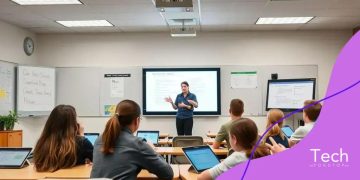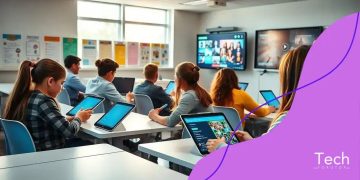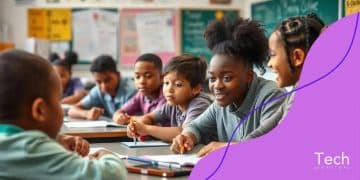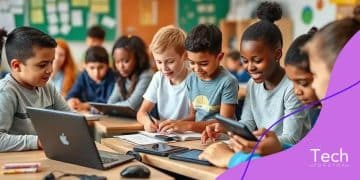Equity in education: why it matters now more than ever

Equity in education ensures all students receive fair access to resources and opportunities, promoting personalized support to help them succeed regardless of their backgrounds.
Equity in education is not just a buzzword; it’s a necessity for creating inclusive learning environments. Have you ever wondered how disparities affect student success? In this article, we’ll delve into the importance of fostering equity in our schools.
Understanding equity in education
Understanding equity in education is essential for ensuring that all students have the opportunities to succeed. It goes beyond just providing access to resources; it involves creating environments where every student’s needs are met. This implies recognizing the diverse backgrounds of students and addressing the barriers that might prevent them from achieving their full potential.
What Does Equity Mean?
Equity refers to fairness and justice in education. It means that each student receives the support they need, rather than everyone getting the same thing. Unlike equality, where everyone is treated the same, equity focuses on providing different levels of support based on individual requirements.
Why Is Equity Important?
Ensuring equity in education is vital for several reasons:
- It promotes academic success for all students, regardless of their background.
- Equity helps to close achievement gaps between different groups of students.
- Fairness in education fosters a more inclusive society and encourages diversity.
By understanding and implementing equity in education, schools can create a safer and more supportive learning environment. Educators can help all students thrive by recognizing the different challenges that each student faces.
How Can We Promote Equity?
Promoting equity in education requires a concerted effort from educators, policymakers, and communities. Here are some effective approaches:
- Implement individualized learning plans for students.
- Provide additional resources for underprivileged communities.
- Encourage parent and community involvement in schools.
The journey towards equitable education involves continuous reflection and a commitment to address the needs of every student. Through collaboration and targeted strategies, we can achieve a more equitable educational landscape for all.
Barriers to achieving equity
Barriers to achieving equity in education are complex and multifaceted. They can stem from various factors that hinder the progress of students from diverse backgrounds. Understanding these barriers is critical to developing effective solutions.
Socioeconomic Factors
One major barrier is socioeconomic status. Students from low-income families often face challenges such as lack of access to resources, including tutoring, books, and technology. This limits their ability to perform well in school. Additionally, financial stress can impact a student’s mental health, further affecting their academic success.
Cultural and Linguistic Differences
Cultural and linguistic differences can also create barriers. When students come from backgrounds that differ significantly from the mainstream, they may struggle to relate to teachers who do not understand their experiences. For instance, students who are English language learners might find it hard to keep up with their peers.
Systemic Inequalities
Systemic inequalities in the education system can disadvantage certain groups of students. Schools in affluent areas typically receive more funding, leading to better facilities and educational programs. In contrast, schools in underprivileged areas may lack essential resources, which directly affects student learning.
Teacher Training and Mindsets
Another barrier can be found in teacher training and mindsets. If teachers are not properly trained to address the diverse needs of their students, it results in inequitable learning experiences. Additionally, teachers’ implicit biases can influence their expectations and interactions with students, which can affect student performance and motivation.
Addressing these barriers requires a comprehensive approach involving educators, policymakers, and the community. Only through awareness and intentional action can we work towards eliminating the obstacles that prevent equity in education.
Strategies for promoting equity

Promoting equity in education requires intentional strategies that address the needs of all students. Implementing effective solutions can help create an inclusive environment where every student has the opportunity to excel. Understanding these strategies is crucial for educators, administrators, and communities striving for improved educational outcomes.
Individualized Learning Plans
Individualized learning plans are a powerful tool for promoting equity. These plans tailor education to meet the unique needs of each student. By assessing individual strengths and weaknesses, educators can provide personalized support, ensuring that no student is left behind.
Resource Allocation
Equitable resource allocation is essential. Schools must focus on providing additional resources to underfunded communities. This may include books, technology, and access to extracurricular activities. Ensuring that every student has adequate resources enhances their learning experience.
Diverse Curriculum
A diverse curriculum can also promote equity in education. Including multiple perspectives in lesson plans helps students connect with the material. A curriculum that reflects various cultures and histories fosters inclusivity and respect for differences.
In addition to these strategies, fostering strong community involvement can greatly enhance equity. When parents and community members engage in schools, students benefit from a support network that encourages educational success. Schools can host events and workshops that bring families together, promoting a sense of belonging.
Professional Development for Educators
Continuous professional development is crucial for teachers. Training focused on cultural competency, bias awareness, and teaching strategies can equip educators to better serve diverse student populations. Schools should invest in regular training sessions to keep teachers updated on best practices.
Combining these strategies can create a robust framework for achieving equity in education. By focusing on individual needs, allocating resources wisely, and fostering community engagement, we can make strides toward a more equitable educational system.
The role of technology in education equity
The role of technology in promoting education equity is increasingly important. Technology can bridge gaps, providing students with access to resources and learning opportunities that might otherwise be unavailable. This access is crucial for creating a more equal educational landscape.
Access to Resources
Technology offers students access to a wealth of information and resources. Online libraries, educational videos, and interactive learning platforms can help level the playing field. With the right tools, students from underserved communities can access high-quality educational materials from home.
Personalized Learning Experiences
Another way technology supports equity in education is through personalized learning experiences. Adaptive learning software can tailor lessons to fit each student’s unique needs. This approach helps ensure that all students can progress at their own pace, maximizing their chances of success.
Collaboration and Communication
Technology enhances collaboration and communication between students, teachers, and parents. Tools like virtual classrooms and messaging apps allow for real-time interaction, making it easier to share ideas and resources. This connectivity fosters a sense of community and engagement, vital for all students.
Furthermore, students can collaborate on projects with peers from different backgrounds, gaining diverse perspectives. This exposure broadens their understanding and appreciation of different cultures, which is essential in today’s global society.
Training and Skill Development
Using technology helps prepare students for the workforce. Digital literacy is increasingly crucial in many careers. Integrating technology into the classroom equips students with the skills they need to thrive in an increasingly digital world.
Despite its advantages, it is essential to address the digital divide. Not all students have equal access to technology, which can exacerbate existing disparities. Schools and communities must work together to provide devices and reliable internet access to ensure that all students benefit from technological advancements.
Real-world examples of equity initiatives
Real-world examples of equity initiatives in education highlight successful strategies that schools and communities have implemented to ensure all students have access to the same opportunities. These initiatives demonstrate how various approaches can lead to positive outcomes for students from different backgrounds.
Community Schools
Community schools are a prime example of fostering equity. They partner with local organizations to provide various services, including health care, mentoring, and after-school programs. This holistic approach helps address the barriers that students face outside the classroom, ensuring they are ready to learn.
Diverse Hiring Practices
Another initiative focuses on diverse hiring practices within schools. By recruiting teachers from various backgrounds, schools can create a more inclusive environment. This representation is essential, as it helps students see themselves reflected in their educators, fostering a sense of belonging.
Scholarship Programs
Many organizations and schools have initiated scholarship programs aimed at underrepresented groups. These programs can significantly reduce financial barriers, allowing students from low-income families to pursue higher education. Scholarships not only provide financial assistance but also inspire students to aim higher academically.
Inclusive Curriculum Development
Inclusive curriculum development is crucial for promoting equity in education. Schools are increasingly incorporating diverse perspectives in their teaching materials. This helps students appreciate and understand different cultures, contributing to a more equitable learning environment.
Moreover, technology plays a vital role in these initiatives. Schools are using online platforms to connect students with resources and learning communities across the globe. This access to information helps to bridge gaps, providing students with the tools they need to succeed.
Overall, these real-world examples show that when communities and educators work together to implement thoughtful initiatives, they can create lasting change and promote equity in education.
In conclusion, achieving equity in education is a shared responsibility that requires collaboration among educators, communities, and policymakers. By understanding the barriers and implementing effective strategies, we can create a more inclusive environment for all students. Real-world initiatives show us that change is possible, and technology can play a key role in leveling the playing field. Working together, we can ensure that every student, regardless of their background, has the opportunity to succeed and thrive in their educational journey.
FAQ – Frequently Asked Questions about Equity in Education
What is equity in education?
Equity in education means providing all students with fair access to resources, opportunities, and support tailored to their individual needs.
How can technology promote equity in education?
Technology enhances equity by providing access to resources, facilitating personalized learning, and encouraging collaboration among students.
What are some real-world examples of equity initiatives?
Examples include community schools, diverse hiring practices for teachers, scholarship programs, and inclusive curriculum development.
Why is addressing barriers important for education?
Addressing barriers ensures that all students, regardless of their background, have the opportunity to succeed in their educational journey.





